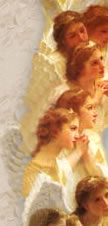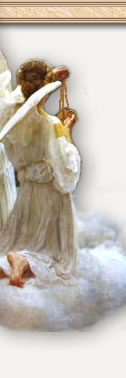




 |
|

|
|
|||||||||||
|
|
|
|
||||||||||||
 |
|
|
||||||||||||
 |
|
 |
|
|||||||||||
|
|
||||||||||||||
 |
 |
|
|
|
|
The Bad Seed Use of the word “fascist” as an epithet to castigate anything one dislikes intensely ought not to blind us to the fact that there is a real historical phenomenon, active in the Second World War, to which the label does indeed apply. This article, building upon my essay in the Spring 2001 issue of The Latin Mass, seeks to demonstrate that important aspects of this fascist phenomenon, developed in the context of that global conflict, are very much reflected in the Novus Ordo Ecclesiae by which the inscrutable designs of Providence have allowed our generation to be tormented. Many a tale needs to be told to convey the truth of this assertion fully; the discussion that follows serves merely as a useful introduction to an extremely delicate and perplexing topic. Let us begin our story in the years 1939-1941, when many Catholics, long convinced of the innate weaknesses of the liberal bourgeois “Established Disorder,” expressed little surprise over the victories of Nazi Germany. What really concerned them was whether Catholicism could find some way to turn a potentially apocalyptic situation to its own advantage. Nowhere was this concern confronted so directly as in France, which became a laboratory in the war years for educational and evangelical schemes designed to reshape the world in a Catholic way. One major example of educational experimentation incorporating both Catholic ideas as well as organizational features of the Ordensburgen, the castle training centers for the new elite of German youth, was the Ecole Nationale des Cadres at the Château Bayard above the village of Uriage, near Grenoble. Founded in the waning months of 1940, it became especially significant by June of 1941, when the Vichy regime determined to require a session at the Ecole for all future high government functionaries. The teachings of a vast array of Catholic luminaries and their fellow travelers were marshalled under the banner of the National Revolution of Pétainist France to play a role in the education offered at Uriage. Still, under the day-to-day direction of Pierre Dunoyer de Segonzac and the guidance of the Study Bureau of Hubert Beuve-Mery, the most potent influences were those of Personalism and what later came to be known as the New Theology. Emmanuel Mounier is the prime representative of the first of these forces. Editor of the journal Esprit, which was dedicated to an elaboration of the personalist vision, Mounier had had pre-war contacts with a kaleidoscope of thinkers engaged in similar speculations: Jean Danielou, the future cardinal; Jean Guitton, who would one day become a close friend and advisor to Pope Paul VI; Jacques Maritain, Nicholas Berdyaev and their circle of friends at the former’s home outside Paris; Henri Daniel-Rops and his fellow members of the organization Ordre Nouveau (New Order); Belgians inspired by the “spiritualized Socialism” of Henri de Man; proponents of European cooperation like Otto Abetz, the Nazi ambassador to defeated France; and a group of “revolutionary National Socialists” gathered in the early 1930s around the Hitler rivals Gregor and Otto Strasser. Mounier’s “communitarian Personalism” was formative in Uriage, even after political problems led to his own removal from the school, through the similar teaching of his friend, Jean Lacroix, and their common master, Jacques Chevalier, Professor at Grenoble and sometime Vichy Minister of Education. The second crucial influence, that of the budding New Theology, arrived in the Chateau Bayard via the Dominican houses of Saulchoir and Latour-Maubourg, the Jesuit center at Fourvières, the journals La vie intellectuelle, Sept and Temps present, the French scouting movement and specialized Catholic Action groups stimulated by the labor of Joseph Cardijn with young Christian workers in Belgium. Segonzac and Beuve-Mery had frequented such circles before the war, bringing to Uriage priests like Henri de Lubac, Jean Maydieu, Victor Dillard and Paul Donceour. These men, in turn, introduced students to the writings of Félicité de Lamennais, Henri Bergson, Maurice Blondel, Charles Péguy, Marie-Domenique Chenu, Yves Congar, Karl Adam, Romano Guardini, Charles de Foucauld and, perhaps more importantly than anyone else, Pierre Teilhard de Chardin. Uriage also had links, direct and indirect, with Frs. Louis Joseph Lebret and Jacques Loew, founders of the Catholic social movement, Economie et Humanisme, destined for a significant “progressivist” future. Through both these conduits, students at the Ecole were familiarized with currents of biblical, historical, spiritual, liturgical and philosophical thought which, while marginal at the moment, would become immensely powerful after the war, and instrumental in guiding the Second Vatican Council and the post-conciliar Church claiming to operate in its name. Again, they were all enthusiastically propagated by a team “ensconced in a chateau up in the mountains with a commission to completely rethink and transform the way France educated its young people” (John Hellman, The Knight Monks of Vichy France: Uriage, 1940-1945, McGill, 1997, p. 56). Transformation of the world, according to the doctrine taught at Uriage, was dependent upon the creation of “persons” as opposed to “individuals.” Allow me briefly to remind readers of my last article that “persons” were defined as men who responded to the call of “natural values” which pressed them to surpass in community life their narrow individual desires. One knew that he was dealing with a community dedicated to a natural value constructing true persons whenever he saw that it possessed a discernible “mystique,” and that it led to creative, self-sacrificing activity. One day, the “convergence” of all such mystiques would result in the establishment of a community of communities producing, in effect, Super-persons, “the greatest transformation to which humanity has ever submitted.” The nightmare of the twentieth century was actually “the bloody birth of a true collective being of men,” mysterious indeed, but providential and eminently Catholic (Ibid., p. 178). Catholicism’s role in this “convergence” was that of giving witness to the supernatural significance of every natural value, reflected in the mystiques of the active communities of self-sacrificing persons it saw around it, and helping each of them to come to its own innate perfection. It must not sit in judgment of them, because Catholicism itself could not fully know what it really was until everything natural had matured and converged. Catholicism was part of a multifaceted pilgrimage to God, linked together by intuition and action, whose destination was unclear. What was important at the moment was encouraging deeply willed commitment to self-sacrifice of all sorts. Hence Uriage’s stunning ecumenism, testified to in a myriad of ways. Beginning with Segonzac’s ability “to form friendly relations, on the spiritual plane, with Protestants, Catholics, Jews, Moslems, agnostics,” since he “preferred (rooted) people…in their own setting, in their own culture” (Ibid., p. 83), it passed through the Uriage Charter’s proclamation that “believers and non-believers are, in France, sufficiently impregnated with Christianity that the better among them could meet, beyond revelations and dogmas, at the level of the community of persons, in the same quest for truth, justice and love” (Ibid., p. 59) and arrived, in Mounier, at full-fledged Teilhardian rapture over the strange growth of the “perfect personal community,” where “Love alone would be the bound, and no constraint, no vital or economic interest, no extrinsic institution” (John Hellman, Emmanuel Mounier and the New Catholic Left: 1930-1950, Toronto, 1981, p. 85): Surely [development] is slow and long when only average men are working at it. But then heroes, geniuses, a saint come along: a Saint Paul, a Joan of Arc, a Catherine of Siena, a Saint Bernard, or a Lenin, a Hitler and a Mussolini, or a Gandhi, and suddenly everything picks up speed...[H]uman irrationality, the human will, or simply, for the Christian, the Holy Spirit suddenly provides elements which men lacking imagination would never have foreseen (Ibid., p. 90). May the democrat, may the communist, may the fascist push the positive aspirations which inspire their enthusiasm to the limit and plenitude. As John Hellman explains, “Mounier’s belief that there was an element of truth in all strong beliefs coincided with Teilhard’s vision of the inevitable spiritualization of humanity” (Ibid., p. 128). Let it be emphasized that the message taught at Uriage was not a rational one. Its ultimate justification was intuition and strength of will leading to creative action. Any appeal to logic, either in support or criticism of strongly willed commitment to natural values was dismissed as either belaboring the given, or dangerous, decadent, individualist scholastic pedantry. Better to bury the temptations of a sickly rationalism through the development of the obvious virtue of “manliness,” again, defined in completely anti-intellectual ways: the ability to leap onto a moving streetcar; to ride a bicycle up the steep hill to the Ecole like Jacques Chevalier; to look others “straight in the eye” and “shake hands firmly”; to endure the sweat-filled regimen labelled décrassage devised for students under the inspiration of General Georges Hébert; to sing enthusiastically around the evening fire in the Great Hall; to know how to “take a woman”; and, always, to feel pride in “work well done.” Such manliness was said to have deep spiritual meaning, aspects of which were elaborated in lectures like de Lubac’s Ordre viril, ordre chrétien (Virile Order, Christian Order), and Chenu’s book, Pour être heureux, travaillons ensemble (For Happiness, Let Us Work Together). Finally, let us note that Uriage’s teaching was unabashedly elitist, the particular mystique of the Ecole being that of developing the natural value of leadership. “The select youth of Uriage” were said to be “the first cell of a new world introduced into a worn-out one” (Hellman, KMV, p. 65), “entrusted with the mission of bringing together the elite from all of the groups that ought to participate in the common task of reconstruction in the same spirit of collaboration” (Ibid., p. 63). Since they were destined to reveal the eternal supernatural significance of the natural values witnessed to by the mystique of all virile communities, Uriage students were actually priestly figures as well. Each class was consecrated and given a great man’s name as talisman. Segonzac especially “took upon himself a certain sacerdotal role, even regarding the wives and children of his instructors” (Ibid., p. 90). This entailed also a “separation between the leaders, the lesser leaders, the lesser-lesser leaders, the almost leaders and the not-at-all leaders” irritating some of the interns. “The central team,” as one of them indicated, “were gods” (Ibid., p. 75). Fascism was seen by the Uriage gods as a “monstrous prefiguration” of the new personalist humanity waiting to be born. It clearly revealed the presence of strong will, virile manliness, self-sacrifice to the community and even, in the context of the war effort, a commitment to the construction of that European-wide order which the leadership thought to be crucial to a more successful unleashing of the creation of spiritualized personalities. Pétain’s so-called National Revolution was appreciated both because of its anti-liberal bourgeois character and its freedom from the gross “materialist” aspects of Nazism, racism in particular. Nevertheless, the deportation of French youth to forced labor camps, the increasing control by Germany of internal Vichy affairs and the outright takeover of the Unoccupied Zone in the latter part of 1942 moved the leadership of the Ecole closer to the growing Resistance Movement. This tendency was matured by December of that year when Uriage’s enemies at court managed to have it expelled from the Château Bayard. But Uriage never did anything haphazardly. Building upon the sense of being a modern version of a band of crusading knights, the exiled Ecole leadership created in 1943 a chivalric Order whose inner circle was bound by special vows of a character that Fr. Maydieu compared spiritually to those of marriage. Members of the Order were to sally forth to show the various elements of the Resistance how to perfect their mystiques in the Uriage manner. Thus, high-level emissaries were sent to contact de Gaulle, and “flying squadrons” into the countryside to guide the maquis so that their deficient mystiques could be “transcended spiritually” and “converge” in the construction of the better world of the personalist-Teilhardian faith. The enthusiasm with which this labor was undertaken was genuine, especially with respect to the Marxist aspects of the Resistance Movement (Marxism, like Fascism, being another “monstrous prefiguration” of a happier future). Here, the Order’s activity was paralleled by the efforts of priests and bishops trying to understand the “mystique” of workers in labor camps and ordinary French factories, training for the latter purpose being offered under the patronage of the supra-diocesan Mission de France. Uriage teachers were themselves involved in these priestly activities – Fr. Dillard, for example, canonizing the Soviets he encountered in the labor camps, and insisting that all workers were born to their task with specific virtues denied to other people. An Uriage-like openness was everywhere in the air. After all, there were “riches in modern disbelief, in atheist Marxism, for example, which are presently lacking to the fullness of the Christian conscience” (Emile Poulat, Les prêtres-ouvrières: Naissance et fin, Cerf, 1999, p. 408). Enlightened spirits had “to share the faith in and the mystique of the Revolution and the Great Day (that of the total Christ)” (Ibid., p. 386), as did one priest who asked to die “turned towards Russia, mother of the proletariat, as towards that mysterious homeland where the Man of the future is being forged” (Ibid., p. 244). The sons of Uriage retained their wartime sense of being a priestly nation, a people set apart, chosen to judge which mystiques were and were not acceptable on the pathway to “convergence.” Objects of contempt offered themselves aplenty. Soviet apparatchiks did not seem to understand that Marxism was meant to be spiritually transcended. A Stalinist mystique, therefore, had to be jettisoned. American culture was even more hopeless. “The Americans,” Beuve-Mery complained, “could prevent us from carrying out the obligatory revolution, and their materialism does not even have the tragic grandeur of the materialism of the totalitarians” (Ibid., p. 213). Jews were dangerous due to their potential spirit of revenge (Ibid., p. 197). Perhaps most of all, however, traditional Catholicism, which, from Uriage days, had feared the “insistence on bringing together men with different ‘mystiques’ while affecting a ‘manly’ irritation with clericalism, dogma and the orthodox” (Ibid., p. 88), needed to be tossed onto the rubbish heap of contempt. Mounier is particularly instructive with respect to this growing dismissal of the Church. His vision had always logically involved the possibility of shelving whole realms of Christian scripture, theology and spirituality, should they clash with the “emerging convergence.” By the last years of the war, “there was little place for sin, redemption and resurrection in the debate; the central acts of the Christian drama were set aside” (Hellman, Mounier, p. 255). Nietzsche’s critique of slavish Christianity now seemed to him to be unanswerable, and he “came to think that Roman Catholicism was an integral part of almost all he hated. Then, when he searched his soul, he discovered that the aspects of himself which he appreciated least were his ‘Catholic’ traits” (Ibid., p. 190). Doing what one willed was the unum necessarium. Everything rational from the Greek tradition used to support Christianity and dampen the will was execrated as well. If there was anything valuable in the Greco-Christian heritage it had to come from personalists rebuilding it from scratch; those appealing to the Catholic name and Catholic practice in his day required diagnosis and psychiatric help:
Metaphysical speculation, Mounier declared, was a characteristic of “lifeless schizoid personalities.”…Mounier even referred to intelligence and spirituality as “bodily diseases” and attributed the indecisiveness of many Christians to their ignorance of “how to jump a ditch or strike a blow.” ... “Modern psychiatry,” Mounier wrote, had shed light on the morbid taste for the “spiritual,” for “higher things,” for the ideal and for effusions of the soul…. Thus, many forms of religious devotion were the result of psychosis, self-deception or vanity. Prayer was often a sign of psychological illness and weakness (Ibid., pp. 192-193). This brings us back to the liturgical question, the liturgy being one of the most important aspects of Christian life that had to change with the emergence of the new personalist order. Uriage was very much permeated with the pastoral emphasis of the more recent liturgical movement, which itself helped to shape its own understanding of the need to accomodate oneself to particular active “mystiques” so as to create self-sacrificing persons. Fr. Maydieu was already celebrating new-style Masses for “friends of Sept” before the war, during which the priest faced the people and provided a French narration (J. Duquesne, quoted in Didier Bonneterre, Le mouvment liturgique, Fideliter, p. 39). Fr. Doncoeur, terrified that life was passing Catholics by, became enthusiastic for pastoral liturgical developments in Germany as early as 1923. He used the model of games and sports events, as well as the general desire of youth to cooperate as a group, to guide the French scouting movement down a new liturgical direction:
Uriage, concerned as it was with using all communal tools to build persons possessing the “leadership mystique,” turned the entire day into a “manly” liturgical experience. Bonfires were lit, backs slapped, virile poems and hymns excogitated, and special pageants mounted. All of these were, of course, inspired by “deep feeling,” and all constituted demands upon the developing persons of the community, rejection of which would have been a breach of Volksgemeinschaft equivalent to an individualist sin against the Holy Spirit. Interestingly enough, all of this participatory, creative and expensive new “natural” liturgical life was being elaborated while Frs. Maydieu, Doncoeur, Chenu, Congar and others were bringing into existence what would be the extremely influential Center for Pastoral Liturgy, designed to effect similar changes on the ecclesiastical level. Worker-Marxist-Soviet mania from 1942 onwards increased the demand for a liturgy based on pastoral response to particular mystiques to fever pitch. This often played upon Pius XII’s well-known willingness to take risks on the pastoral level if success could be demonstrated to emerge from them. Henri Godin’s famous work, France: Pays de Mission? (1943), outlining worker dechristianization, had created a sense of crisis. Prudence had to be tossed aside. Lack of any precise plan for diving into the worker mystique was attributed to genius and faith in the Spirit. One thing alone was certain: the liturgy and the priesthood were out of sync with the world of labor. All that was associated with what Paul Claudel called the “mass with one’s back to the people” had to be abandoned. It had become the precious toy of little minds and bigots who could not understand the New Order coming into being around them. Hence the critique of Fr. Dillard, who dismissed the difficulties of a total rejection of the past, and also took it for granted that the worker clientele would be able to sense the superior spirituality of what we would call a secularized clergy due to the je ne sais quoi emanating from its own new mystique:
It ought to be obvious by this point that the war and efforts to respond to its challenges gave much greater exposure to many of the ideas, men and expressions of contempt for believers which were instrumental in assembling the Novus Ordo Ecclesiae. Le Monde, under Beuve-Mery’s leadership, has alone been worth thousands of extra mileage en route towards the Omega Point, with automatic upgrades to first-class seats for everyone of the Uriage personalist persuasion. But what are we to conclude about the other argument touched upon at the beginning of this essay? Is there then any validity to the claim of a fascist-like character to the ecclesiastical universe in which we now live and gasp for a breath of the supernatural? Very little, it would seem, in the minds of those people for whom Fascism means anti-Semitism and racism alone. Participation of many of the architects of the Novus Ordo Ecclesiae in the Resistance Movement and in vigorously anti-Nazi journals like Témoignage chrétien, seems to provide unquestionable protection from any accusation of Fascism whatever, even when such involvement had been preceded by several years of respectable flirtation with Pétain and the National Revolution. Nevertheless, for those manly spirits ready to leap from streetcars moving towards undiscernable destinations, to sit down in a cafe and to indulge in a little scholastic logic, the issue cannot be dismissed so easily. Fascism is more than Hitler. It is even more than Mussolini, its twentieth-century “founder.” It is a phenomenon that emerged out of the same concern to restore a shattered Western social order by appeal to the non-rational will of virile communities stirred to action by charismatic prophets central to the preaching of Lamennais and a whole tradition following from him that was appealed to by the teachers of Uriage. Yes, aspects of contemporary Fascism may have been of secondary importance to the Catholics we have been discussing, but the canonization of submission of the individual to the will of the non-rational community was common to both. What difference if Catholic-friendly words like “person,” and expressions such as the “Mystical Body of Christ” were employed, when rigorous philosophical-theological examination of their meaning was ridiculed as decadent and unnecessary to men with “deep faith” in the emergence of the better world towards which their natural leaders were guiding them? Nineteenth-century Catholics opposed to Lamennais knew what to expect from his vision, and their critique, present in the writings of men of the day like Louis Veuillot and the Jesuit editors of La Civiltà Cattolica, underlined many of the problems of the fascist experience and any Christian personalism related to it as well. Burial in vital community life alone cannot, on its own, produce spiritual “persons” of any supernatural significance. The very conception of the person requires the unique Christian mentality judging the will and action of the “mystiques” from which it is supposed by the men of Uriage to emerge. Forgetfulness of this basic principle was bound to entail the creation of hollow men, swaying according to the vagaries of each and every “vital,” willful, all-too-fallen, worldly wind. This is why the claim to “spiritualize” and “transcend” all of life by basing that transformation on burial in the activity of natural communities is also an empty one. “Spiritualization” of everything natural, as practiced by the thinkers we have been discussing, ends in the naturalization of everything which might have been lifted up to God, had the tools for accomplishing that goal not been rejected, and an opening been given instead to all the gross, banal and frequently inane fantasies to which the human mob always feels its deepest pull. No insistence upon one’s innate virtues and natural leadership skills can save those attempting to guide such a false spiritualization from a depressing fall to earth. Hence, the deeply committed Fr. Dillard ended by concluding that his work in the factory was more important than his Mass, and, indeed, that the machine on which he labored itself actually had a soul (Poulat, p. 327). Similarly, Mounier’s Ascent of Mount Carmel jettisoned prayer for psychoanalysis, while the Monde milieu helped mightily to build a technocratic Europe marked by the same bland, materialist “diversity” of the American pluralist circus it so self-righteously condemned. Let us allow the final word to go to Jacques Maritain and his early critique of the direction certain personalists were headed with their understanding of the manner in which life might all be spiritualized. The unique significance of Catholicism was abandoned by their approach, he complained, and the result would be that they would find themselves helpless before any substantive phenomenon, spiritiually “barren in the face of a Ramakrishna” (Hellman, Mounier, p. 42).
|
|



♦ About The Mass ♦ Resources ♦ How To Help ♦ Contact Us ♦